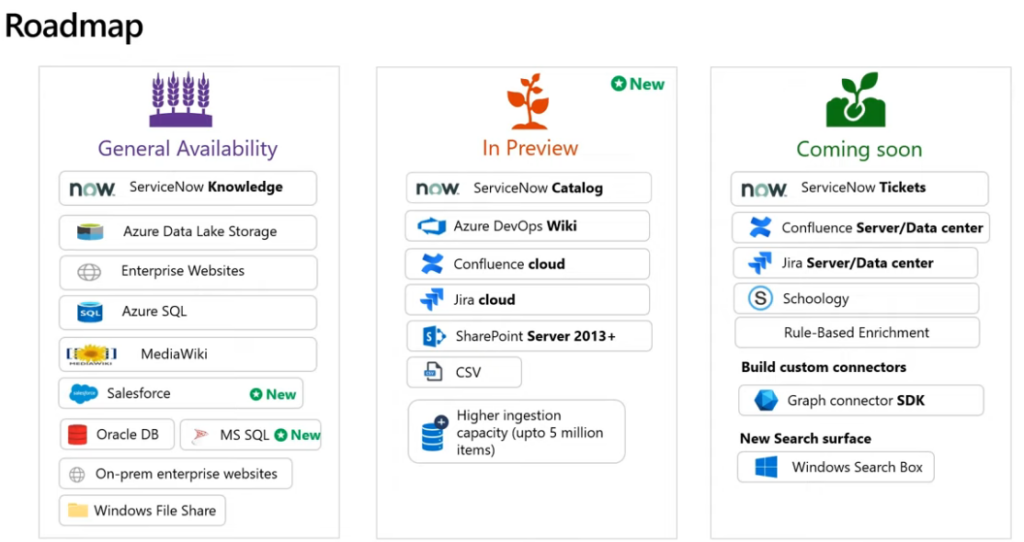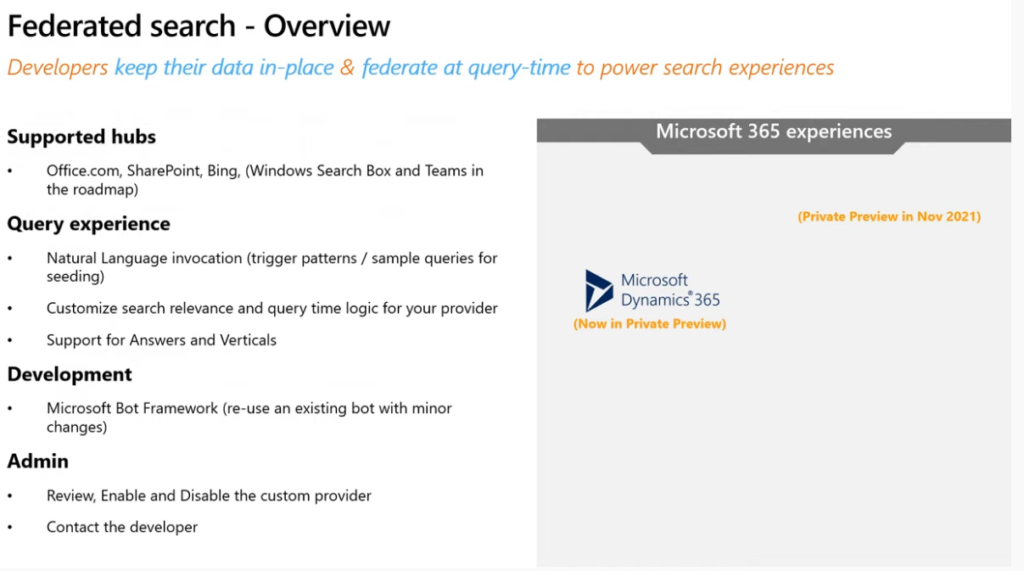updated: Feb 13, 2022
(Old/Classic) SharePoint Search: content-centric (SharePoint Search Center)
(New/Modern) Microsoft Search: people-centric (Teams, Office, OneDrive, Delve etc.)
Office graph = codename for collective set of services and insights we generate on top of the infrastructure that fast office graph group developed
= social Intel concepts (SharePoint home, Delve, OneDrive Discoverview) are derivatives of Office graph
Microsoft Graph = API ( including universal search API)
The Graph Search API went General Availability (GA):
– Microsoft Search API in Microsoft Graph
– Use the Microsoft Search API to query data
– Microsoft Search API Code samples, Tutorials at github
Microsoft Search API provides one unified search endpoint that you can use to query data in the Microsoft cloud – messages and events in Outlook mailboxes, and files on OneDrive and SharePoint – that Microsoft Search already indexes.
Turing technology – understands you, answers your question e.g. hover over doc -> doc summary (based on “deep speed” AI model)
announcement at Ignite Spring, more on Ignite Fall 2021
Modern Search: MS nailed the fundamentals, now start bringing it everywhere – to Teams first, then SharePoint (said Nov 2020).
Modern Search Customizations – we’ll take the best from Classic SharePoint Search,
a lot will retire – investing in more flexibility
PnP modern Search
– custom result pages, webparts, branding theme; filters, refiners, scoping control )
pnp modern search – webparts (video)
https://microsoft-search.github.io/pnp-modern-search
Core idea behind Microsoft search is coherence
Bill Baer:
“People use search in a different ways
1) you have organisations who have a well-established intranet built around set of governance controls, a very clean architecture and they want to build a search into that intranet scenario; that’s why a lot of SharePoint capabilities are going to come along with Microsoft search for that particular endpoint
2) then you have other people who live their day in teams“
Updates
Shared search engine results page (developed once – transitioned everywhere)
Ctrl-F to search through teams (chats?) (contextual search)
Natural language search (starting from Outlook)
Image search (before eoy), +
Metadata content type search Syntex customers will be able to use content type to search in the advanced search flyout in document libraries that contain content types beyond the default types. Syntex only.
Conversations: teams chats, outlook groups conversations, yammer conversation can be found under Conversations vertical in Bing search. Later – in Office.com and SharePoint landing page.
E-mail messages are added to Conversations vertical in Bing search
Bookmarks (new promoted results), acronyms, Q&A – all under “Answers”
Bookmarks Targeting – for the specific audience based on device/OS, Country/Region, security groups…
SharePoint Search Admin Center -> will be migrated from SharePoint admin center to to Microsoft Search Admin Center transitioning (Search and Intelligence Admin Center) – long-running project custom dictionaries, spelling suggestions – will retire, (move to a graph-driven speller)
+ Viva Topics – based search capabilities
- Create Topic Answers with Microsoft Viva Topics to bring together people, content, and information (including synonyms and acronyms)
- Knowledge answers provide a direct answer to questions authoritative information in an organization across SharePoint and OneDrive content
- Files/Calendars/Links answers
Graph Connectors
Graph Connectors are generally available (ADLS – Azure Data Lake Storage Gen2, Azure DevOps, Azure SQL and Microsoft SQL Server, Enterprise websites, MediaWiki, File share, Oracle SQL, Salesforce, Jira, Confluence, ServiceNow + 100+ from partners; New connectors coming to Microsoft Search: Jira Graph connector, Confluence Graph connector).
Graph Connector allows to connect external source of information to Microsoft 365 and makes that data available across all m365 apps and services so you can find what you need wherever you’re working, whether in one of your favorite productivity apps or one of the many Microsoft 365 services such as SharePoint or Office.com
Graph Connectors roadmap:

Actionable experiences
Search results on select Graph connectors will soon support actions that will allow users to interact with the result and perform changes to the Connector content within the Search application.
Results clusters
The results shown in a result cluster are grouped together based on the search vertical configuration.
Profile Query variables
Define any attribute from the user’s Profile, as a query variable and it would be resolved during query evaluation (This feature is currently in preview)
Profile enrichment with Graph connectors
…you will soon be able to enrich Microsoft 365 profile properties like Job title, Phone numbers, Skills etc. with data from HRMS systems using graph connectors. …then surface this rich profile information on people experiences like profile cards.
Search Federation
federation capabilities will allow enterprises build and integrate their custom LOB search experiences, customized search providers, into the overall Microsoft Search. With federated search, you can make information from systems where the data cannot leave the systems boundaries available to search across in Microsoft 365 productivity apps and services, without indexing its data with Microsoft Search.

Azure Cognitive Search Federation
PowerBI search vertical
Custom verticals and custom refiners
Custom result templates – search layout designer – wysiwyg editor
– Manage search result layouts
– Microsoft Search Layout Designer
Standalone Search – AAD identity – Graph connector – Ingest your data – use Search = in Windows 10, Office.com ( e.g. for those who have their data in other productivity suite, have no intent to use m365, but want to search)
More info:
References
Bill Baer “Making the most of Microsoft Search” @ MS Ingnite fall 2021
Current state of SharePoint Search and Microsoft Search scopes
Bill Baer: What’s new and what’s next for Microsoft Search (May 25, 2021)
Pingback: Office 365 Search scopes ⋆ Vladilen